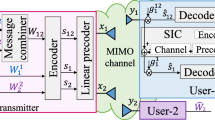Abstract
We study in this paper multiuser uplink scheduling algorithms for Multiple-Input Multiple-Output (MIMO) systems, where the multiusers compete for the MIMO Channel and the scheduler selects one user at a time based on a certain criterion. Then the selected user spatially multiplexes his data over the transmit antennas. This spatial multiplexing (SM) scheme provides high data rates while the multiuser diversity obtained from scheduling improves the performance of the uplink system. At the receiver, the Vertical-Bell-Labs LAyered Space Time architecture (V-BLAST) is used to detect the information layers. The main contribution of this paper is proposing and comparing the performance of several scheduling criteria for MIMO uplink scheduling. In addition, novel V-BLAST capacity bounds based on random matrix theory is presented. Furthermore, we investigate suboptimal schedulers and compare their performance. The main results of this study show that the scheduler that maximizes the optimal MIMO capacity doesn’t work well for a V-BLAST system. Instead, the optimal scheduler that maximizes the V-BLAST capacity is derived and analyzed. In addition, we look into scheduling for SM with sphere decoding and we find that in this case, using MIMO capacity as the scheduling criterion performs the best.
















Similar content being viewed by others
References
Knopp, R., & Humblet, P. (1995). Information capacity and power control in single cell multiuser communications. In Proceedings of the IEEE international computer conference (ICC’95), Seattle, WA.
Tse, D. N. C. (1997). Optimal power allocation over parallel Gaussian channels. In Proceedings of international symposium on information theory. Ulm, Germany.
Heath, Jr., R. W., Airy, M., & Paulraj, A. J. (2001). Multiuser diversity for MIMO wireless systems with linear receivers. In Signal, systems and computers 2001, conference record of the thirty-fifth asilomar conference on, vol. 2, pp. 1194–1199.
Airy, M., Shakkattai, S., & Heath, Jr., R. W. (2003). Spatially greedy scheduling in multi-user MIMO wireless systems. In Signals, systems and computers, 2003. Conference record of the thirty-seventh asilomar conference on, vol. 1, pp. 982–986.
Wang, L.-C., & Yeh, C.-J. (2010). Scheduling for multiuser MIMO broadcast systems: Transmit or receive beamforming? IEEE Wireless Communications, 9(9), 2779–2791.
Pan, C.-H., & Lee, T.-S. (2013). Efficient QR-based multi-mode precoding for limited feedback multi-user MIMO systems. Wireless Personal Communications, Published Online, pp. 1–19.
Gozali, R., Buehrer, R. M., & Woerner, B. D. (2003). The impact of multiuser diversity on space-time block coding. IEEE Communications Letters, 7(5), 213–215.
Lau, V.K.N., Liu, Y., & Chen, T.A. (2002). Optimal multi-user space time scheduling for wireless communications. In IEEE 56th VTC 2002-Fall. (2002), vol. 4, pp. 1939–1942.
Al-Ghadhban, S., Buehrer, R. M., & Robert, M. (2007). Uplink scheduling criteria comparison for V-BLAST users. In 9th international symposium on signal processing and its applications, 2007, pp. 1–4.
Wolniansky, P. W., Foschini, G. J., Golden, G. D., & Valenzuela, R. A. (1998). V-BLAST: An architecture for realizing very high data rates over the rich-scattering wireless channel. In Proceedings of ISSSE-98, Pisa, Italy, pp. 295–300.
Choi, J., & Adachi, F. (2010). User selection criteria for multiuser systems with optimal and suboptimal LR based detectors. IEEE Transactions on Signal Processing, 58(10), 5463–5468.
Bai, L., Chen, C., Choi, J., & Ling, C. (2011). Greedy user selection using a lattice reduction updating method for multiuser MIMO systems. IEEE Transactions on Vehicular Technology, 60(1), 136–147.
Mao, J. L., Gao, J. C., Liu, Y. A., Xie, G., & Zhang, J. (2012). Robust multiuser MIMO scheduling algorithms with imperfect CSI. Science China Information Sciences, 55(4), 815–826.
Foschini, G. J., & Gan, M. J. (1998). On limits of wireless communications in a fading environment when using multiple antennas. Wireless Personal Communications, 6, 311–335.
Papadias, C. B., & Foschini, G. J. (2002). On the capacity of certain space-time coding schemes. EURASIP Journal on Applied Signal Processing, 2002(5), 447–458.
Loyka, S., & Gagnon, F. (2004). On BER analysis of the BLAST without optimal ordering over Rayleigh fading channel. In Vehicular technology conference, VTC2004-Fall, IEEE 60th, vol. 2, pp. 1473–1477.
Jiang, Y., Zheng, X., & Li, J. (2005). Asymptotic performance analysis of V-BLAST. In Global telecommunications conference, 2005. GLOBECOM ’05. IEEE, vol. 6, p. 3886.
Lee, H., & Lee, I. (2006). Channel capacity of BLAST based on the zero forcing criterion. In Vehicular technology conference, VTC 2006-Spring. IEEE 63rd, vol. 4, pp. 1615–1619.
Edelman, A. (1988). Eigenvalues and condition numbers of random matrices. SIAM Journal on Matrix Analysis and Applications, 9(4), 543–560.
David, H. A. (1970). Order statistics (1st ed.). New York: Wiley.
Gordon, Y., Litvak, A. E., Schutt, C., & Werner, E. (2006). On the minimum of several random variables. Proceedings of American Mathematical Society, 134(12), 3669–3675.
Bertsimas, D., Natarajan, K., & Teo, C.-P. (2006). Tight bounds on expected order statistics. Probability in the Engineering and Informational Sciences, 20(4), 667–686.
Zhang, X., Lv, Z., & Wang, W. (2008). Performance analysis of multiuser diversity in MIMO systems with antenna selection. IEEE Transactions on Wireless Communications, 7(1), 15–21.
Acknowledgments
The author would like to acknowledge the support provided by King Fahd University of Petroleum and Minerals (KFUPM) and King Abdulaziz City for Science and Technology (KACST) for funding this work through project number AR-29-79.
Author information
Authors and Affiliations
Corresponding author
Additional information
This paper was partially presented in the 9th International Symposium on Signal Processing and Its Applications in Sharqah UAE 2007. Compared to the conference paper, scheduling criteria analysis are added and novel V-BLAST capacity bounds are derived in this paper. In addition, more comparisons and insights on the performance of the different scheduling criteria are presented and discussed.
Rights and permissions
About this article
Cite this article
Al-Ghadhban, S.N. User Selection Criteria for Uplink Spatial Multiplexing MIMO Systems. Wireless Pers Commun 79, 487–507 (2014). https://doi.org/10.1007/s11277-014-1869-x
Published:
Issue Date:
DOI: https://doi.org/10.1007/s11277-014-1869-x




